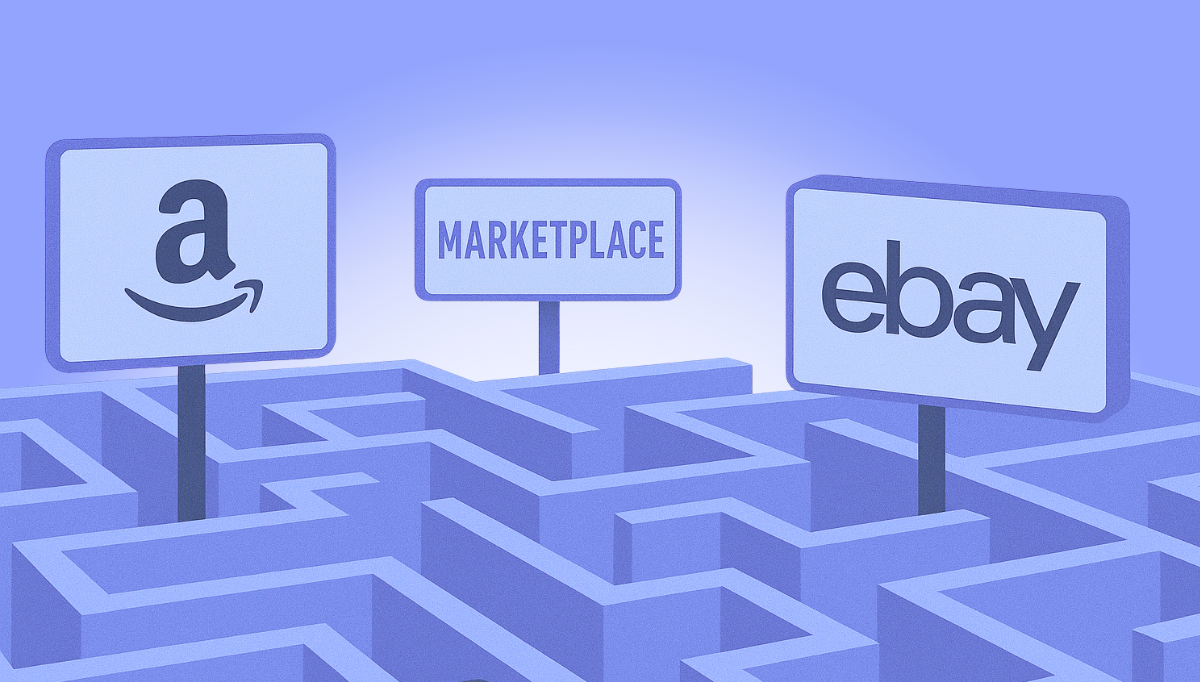The marketplace maze: why expanding beyond Amazon, eBay, and Zalando is essential for fashion brands

Your biggest competitor isn’t necessarily the brand selling similar products on Amazon. It could be the fashion brand you’ve never heard of that’s quietly and methodically expanding into marketplaces that fit its selection, price point, and customer profile. Amazon, eBay, and Zalando have long been the cornerstone of many fashion brands’ marketplace strategies. They offer massive audiences, proven sales channels, and convenient logistics. But reach alone isn’t a strategy.
As margins shrink and costs grow, dependence on one or two platforms becomes a vulnerability. Amazon fees are 15% or less in most product categories, but sellers report that margins on alternative platforms, such as Shopify, are up to double what they are on Amazon. And relying on a single platform can lead to massive costs if an account is suspended or penalized, even temporarily. In one scary example, Couple’s Coffee had a five-day suspension lead to $15 – $17 thousand in lost sales.
When major channels lose momentum
It’s tempting to double down on Amazon: it’s what you know, it’s simple, and it’s profitable. In 2024, Amazon’s ecommerce sales were nearly triple the combined online sales of Walmart, Target, and Costco.
But scale doesn’t guarantee stability. Algorithm shifts, fee increases, and rising traffic costs happen while selling on any marketplace. Concentrating too heavily on just one or two channels limits your ability to absorb disruption, test new strategies, or shift focus when performance fluctuates. Items that stall on Amazon, for example, might reach engaged shoppers on trend-driven TikTok Shop or Zalando’s fashion-first marketplace.
The fashion industry also faces unique challenges that make marketplace diversification essential:
- Gen Z shopping behavior: Nearly 50% of Gen Z shoppers said they would shop through social media this year. Fashion brands need to meet younger consumers where they shop, and that’s increasingly on platforms like TikTok Shop and Instagram, not just traditional marketplaces. TikTok Shop is a top five sales channel for Rithum.
- Rising competition costs: As more than one million sellers join Amazon annually, advertising costs increase while organic visibility declines.
- Highly seasonal inventory demands broader reach: Fashion operates on quarterly cycles. When you’re limited to two to three platforms, you’re essentially limiting seasonal inventory to a fraction of available consumer touchpoints. Retailers like Shein are bringing new designs to market in as little as 15 days, shortening trend cycles even further. Every new collection represents an opportunity to test different marketplaces and demographics.
Meanwhile, fashion-focused marketplaces are growing rapidly, offering curated experiences and loyal audiences. Zalando, Europe’s leading fashion marketplace, ended 2024 with 51.8 million active customers, up about 4.5% from 2023. Their success illustrates that fashion-first platforms are attracting engaged consumers with strong conversion potential. Fashion brands should pay attention.
Barriers to expansion on new sales channels
So you know you need to grow on new marketplaces, but you’re stuck on how. Expanding to just one new marketplace involves adapting product data, pricing logic, inventory syncing, and fulfillment operations, not to mention learning each channel’s unique policies and promotion mechanics. Scaling to several can feel like an operational nightmare.
Based on conversations with customers, we see these common pain points come up again and again:
- Marketplace complexity: Managing inventory, content, pricing, fulfillment, and promotions across multiple platforms quickly becomes overwhelming. Boardriders found that “scaling from 140 to 190 channels in a year would have been a logistical nightmare,” without Rithum.
- The need for new growth: Established sellers often hit a ceiling: more ad spend doesn’t always yield more sales. Identifying new, high-potential channels, especially niche or regional marketplaces, can be elusive. Turkish brand Jimmy Key saw potential customers in Germany, Italy, the Netherlands, and other European countries. It reached them by expanding to four new marketplaces with Rithum and subsequently exceeded sales targets by 300%.
- Scaling DTC brands: As brands grow beyond their own site, consistency becomes harder. Maintaining accurate content, inventory, pricing, and branding across diverse channels is a challenge without central control. ASICS faced this exact challenge, with a product catalog too large for a single person to manage.
Rithum: solutions to roadblocks
With Rithum, you can manage content, inventory, orders, and performance across dozens of channels from one centralized system. That means faster time-to-market, cleaner catalog governance, and a significant reduction in the manpower required to scale. Jimmy Key experienced this transformation firsthand, and product listings that once took weeks to go live now take one to two business days
Our AI Magic Mapper automatically aligns your products with marketplace-specific categories and requirements, eliminating the manual work that kills expansion momentum.
Through our Commerce Network, brands can analyze channel performance data and identify the best marketplace opportunities for their specific catalog and customer demographics. Boardriders used this capability to expand channels by 35% while increasing sales value 15x from 2014 to 2024.
For fashion brands looking to scale DTC operations, this centralized infrastructure is essential. As you grow beyond your own website, consistency across channels becomes harder to maintain (want an example of how it could go right? With Rithum’s help, ASICS centralized their approach and launched on Amazon, achieving 72% year-over-year revenue growth and 150% growth during their Cyber 5 period).
Rithum helps preserve brand integrity while also enabling expansion into new revenue streams, regions, and audiences.
Expansion isn’t optional for brands anymore
Consumers are branching out from the old guard of established marketplaces to explore new spaces, like TikTok Shop, Instagram, Shein, and Temu. If your brand isn’t meeting them where they are, someone else will. Book & Mortar Record Store LLC proved this opportunity exists: After automating their TikTok Shop integration through Rithum, they went from adding 30 products per day manually to 1,000 products per day, with sales jumping 250% in their first month and 694% the following month.
If any of these resonate, you’re likely overdue for marketplace expansion:
- Stalled growth: Your Amazon/eBay sales are flat.
- Margin pressure: Fees and advertising costs are rising.
- Audience ceiling: You’re seeing diminishing returns from branded channels.
- Algorithm shock: Recent ranking changes have dented impressions or conversions.
- Competitive crowding: New brands are overtaking you in category rankings.
If your team is spending more time fighting for incremental gains on Amazon than making bold moves elsewhere, it’s time to reassess your strategy. Broader marketplace expansion might feel intimidating, but with the right partner, it doesn’t have to be.
Whether you’re navigating how to enter new channels, exploring long-tail opportunities, or simply trying to bring order to multi-marketplace chaos, Rithum is built to help fashion brands break through the noise and scale.
Marketplace selling will only get more complex from here. But the brands who embrace that complexity, armed with the right tools, will find themselves with stronger margins, broader reach, and more control over their future.
Explore how diversified marketplace selling can fuel your next wave of growth. Schedule a demo today
Samantha Howard is Head of Merchandising at Rithum.
 Back to all
Back to all








